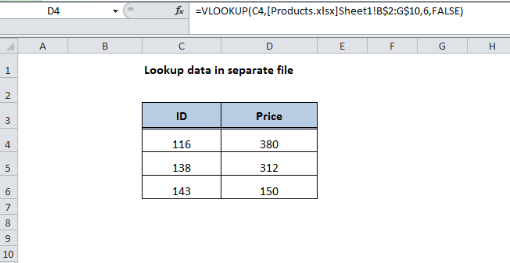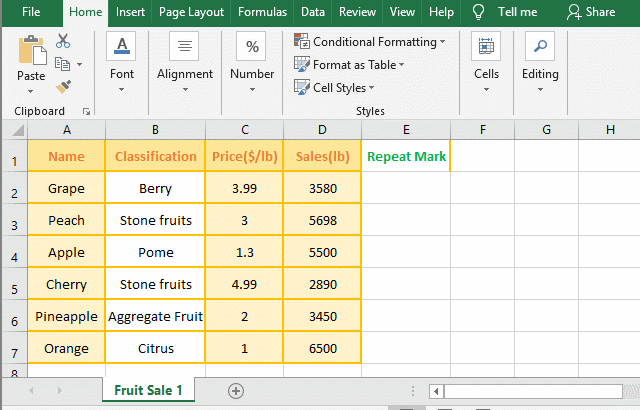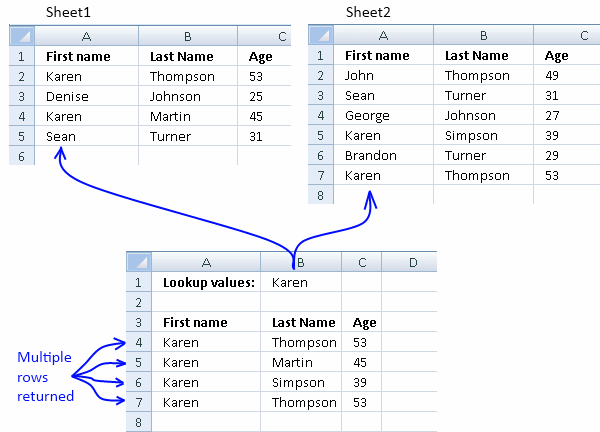

What happens when you leave the range_lookup argument blank?
#How to use vlookup in excel on two different sheet how to#
You can do so using the ROUND function.Īlso read: How to Password Protect Your Excel Workbook Frequently Asked Questions 1. Fixing this is pretty easy: round up your number by a maximum of five decimal places, and it should work. With VLOOKUP, if you have a figure that has too many numbers after the decimal point, you will end up with an #NA error. Excessively large floating point numbersĮssentially, floating point numbers are numbers that have decimal points. Non-printing characters can also prevent VLOOKUP from finding items properly. If you’re absolutely certain there should be a match in your lookup_value, then you’ll want to double-check the information in your table array to make sure everything is properly formatted and doesn’t have unwanted spaces. If you have this argument set to FALSE, and VLOOKUP is unable to find an exact match, you’ll end up with an #NA error. The last value in your VLOOKUP formula is your range_lookup argument that you either set to TRUE for an approximate match or FALSE for an exact one. To remedy this, you can either tweak your formula to reference a different column or move your columns so that the lookup_value is in the right place. If your lookup_value isn’t there, it’ll result in an #NA error.

One of VLOOKUP’s biggest limitations is that it can only search for values in the very first column of your table array. Your Lookup_value is not in the first column of your table array. The most common error you’ll come across when using VLOOKUP is the “#NA” error, though it’s worth noting that there are a variety of reasons this error would appear. This turns them into absolute values that won’t shift when the formula is copied.Īlso read: 3 Ways to Split Cells in Microsoft Excel Usual VLOOKUP Errors and How to Fix Them To prevent this, place your cursor on the values in your formula and hit the F4 key. The problem is, the values specified in the function string will shift downwards as well, ruining the whole formula. One of the most useful things about VLOOKUP is that you can drag the formula down to copy it across various cells. DO use F4 when copying the formula to other cells. Input the wrong “col_index_num” value in your string, and the function will show a completely different result. The value of the first column is considered 1, the second 2, and so on. The “col_index_num” or column index number is the numerical value set for each column in your table array. What VLOOKUP displays depends heavily on you setting the correct “col_index_num” when typing out the string. Many users mistakenly use TRUE, which could lead to inaccurate results, or they forget to set a value at all. The last part of your VLOOKUP string lets you dictate whether the value is FALSE for an exact match or TRUE for a partial match. DON’T forget to use FALSE for exact matches. Put your lookup_value anywhere other than the beginning, and the function will fail. It’s only able to display information if that value is in a succeeding cell from the same row. VLOOKUP functions under the assumption that your lookup_value is in the first column in your table array. DO make sure that the Lookup_Value is the first column in your table. Here are a few things to keep in mind when trying VLOOKUP. Most Excel veterans have been there at some point in their lives. There’s no shame in making a few mistakes when you’re new to the VLOOKUP function. But if the sheet is meant for experts, then INDEX-MATCH is probably the way to go.

Through the use of a helper column, you’d have a unique identifier that can help VLOOKUP differentiate between the different “Iris Watsons” in your sheet.Īt the end of the day, many more people know how to use VLOOKUP compared to INDEX-MATCH, so the former is probably the better pick if the sheet will be accessed by many non-advanced users. Let’s say, for example, that our table has multiple cells with the name “Iris Watson.” Under normal circumstances, VLOOKUP would only pull up the first “Iris Watson” it finds on the list, but you could be looking for a different one. This is useful in cases where you have multiple cells with the same value. By using a helper column, you can create unique identifiers that store information from multiple cells, then tweak VLOOKUP to look for these unique identifiers instead. VLOOKUP was designed to only pull up a single value, and there are other functions for looking up multiple sources of information – that’s not to say that you can’t use VLOOKUP to search multiple criteria. Note: this guide uses Microsoft Excel to perform the VLOOKUP, but you can use the same method with Google Sheets.Īlso read: How to Use the Concatenate Function in Excel How to Filter Data Using Multiple Criteria


 0 kommentar(er)
0 kommentar(er)
